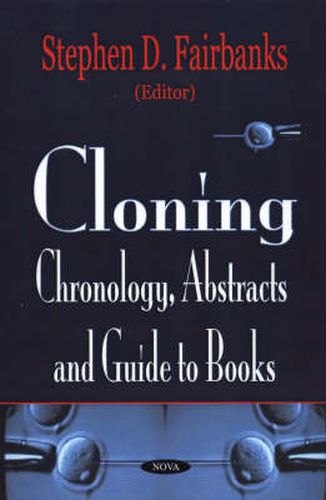Readings Newsletter
Become a Readings Member to make your shopping experience even easier.
Sign in or sign up for free!
You’re not far away from qualifying for FREE standard shipping within Australia
You’ve qualified for FREE standard shipping within Australia
The cart is loading…






The terms ‘recombinant DNA technology’, ‘DNA cloning’, ‘molecular cloning’ or ‘gene cloning’ all refer to the same process: the transfer of a DNA fragment of interest from one organism to a self-replicating genetic element such as a bacterial plasmid. The DNA of interest can then be propagated in a foreign host cell. This technology has been around since the 1970s, and it has become a common practice in molecular biology labs today. Reproductive cloning is a technology used to generate an animal that has the same nuclear DNA as another currently or previously existing animal. Dolly was created by reproductive cloning technology. In a process called ‘somatic cell nuclear transfer’ (SCNT), scientists transfer genetic material from the nucleus of a donor adult cell to an egg whose nucleus, and thus its genetic material, has been removed. The reconstructed egg containing the DNA from a donor cell must be treated with chemicals or electric current in order to stimulate cell division. Once the cloned embryo reaches a suitable stage, it is transferred to the uterus of a female host where it continues to develop until birth. Therapeutic cloning, also called embryo cloning, is the production of human embryos for use in research. The goal of this process is not to create cloned human beings, but rather to harvest stem cells that can be used to study human development and to treat disease. Stem cells are important to biomedical researchers because they can be used to generate virtually any type of specialised cell in the human body. This new book presents an up-to-date Chronology of Cloning along with current and selected abstracts dealing with cloning as well as a guide to books on the topic. Access to the abstract and books sections is provided by title, subject and author indexes.
$9.00 standard shipping within Australia
FREE standard shipping within Australia for orders over $100.00
Express & International shipping calculated at checkout
The terms ‘recombinant DNA technology’, ‘DNA cloning’, ‘molecular cloning’ or ‘gene cloning’ all refer to the same process: the transfer of a DNA fragment of interest from one organism to a self-replicating genetic element such as a bacterial plasmid. The DNA of interest can then be propagated in a foreign host cell. This technology has been around since the 1970s, and it has become a common practice in molecular biology labs today. Reproductive cloning is a technology used to generate an animal that has the same nuclear DNA as another currently or previously existing animal. Dolly was created by reproductive cloning technology. In a process called ‘somatic cell nuclear transfer’ (SCNT), scientists transfer genetic material from the nucleus of a donor adult cell to an egg whose nucleus, and thus its genetic material, has been removed. The reconstructed egg containing the DNA from a donor cell must be treated with chemicals or electric current in order to stimulate cell division. Once the cloned embryo reaches a suitable stage, it is transferred to the uterus of a female host where it continues to develop until birth. Therapeutic cloning, also called embryo cloning, is the production of human embryos for use in research. The goal of this process is not to create cloned human beings, but rather to harvest stem cells that can be used to study human development and to treat disease. Stem cells are important to biomedical researchers because they can be used to generate virtually any type of specialised cell in the human body. This new book presents an up-to-date Chronology of Cloning along with current and selected abstracts dealing with cloning as well as a guide to books on the topic. Access to the abstract and books sections is provided by title, subject and author indexes.